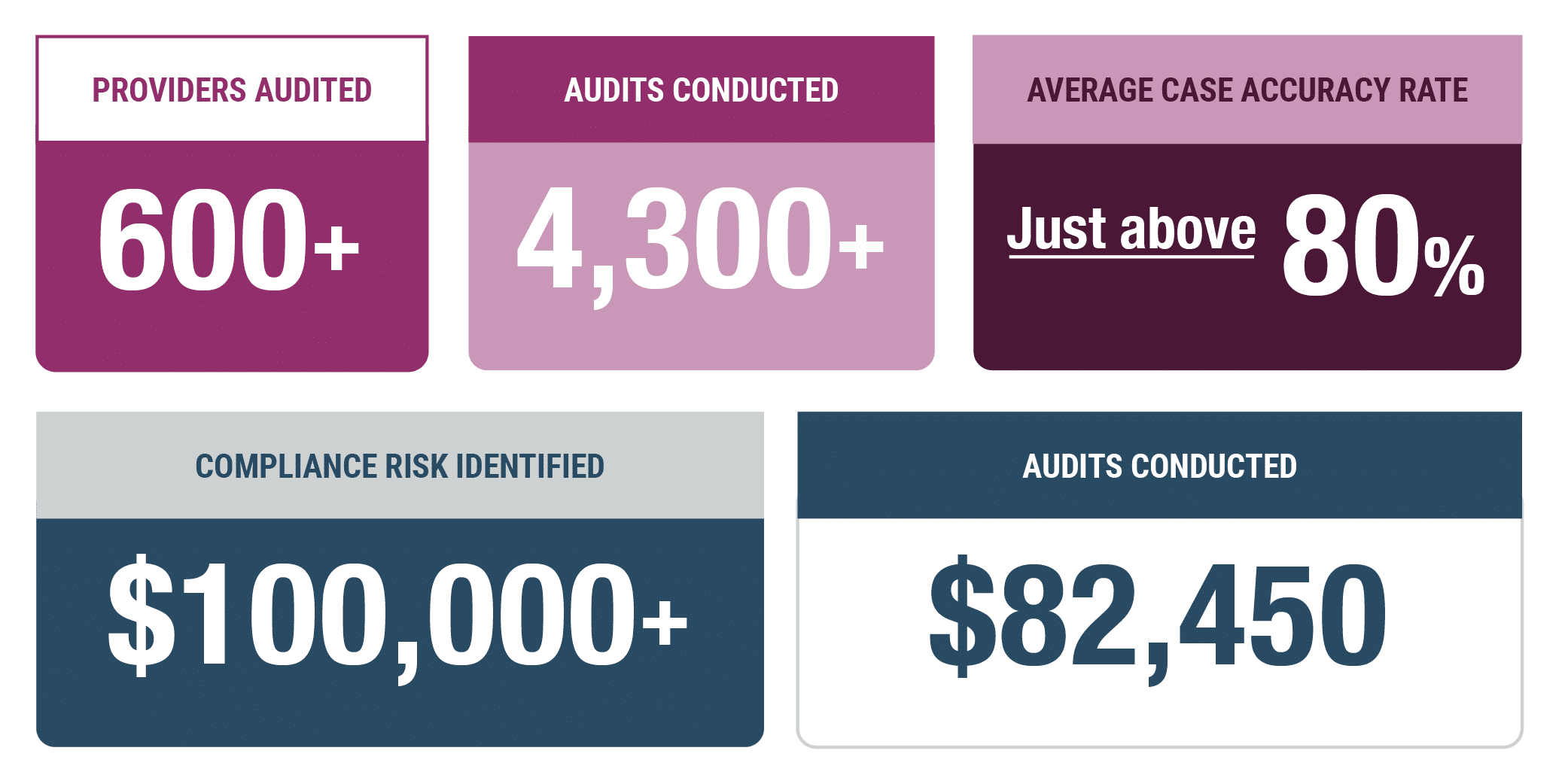THE CUSTOMER PROFILE
This medical group is a large pediatric multi-specialty organization. The group includes pediatric specialists in many specialty areas and provides focused services for complex conditions. Its mission is to provide integrated, pioneering care to patients, optimize children’s health, build interdisciplinary clinician teams, and train future generations.
THE CHALLENGE
Lack of automation led to limited audits, generic education, and time-consuming document management.
This pediatric-focused organization has an extremely lean compliance department dedicated to providing large amounts of vital executive guidance and clinician education. The team performs professional billing audits across multiple settings, from hospitals and clinics to private practices.
Before implementing MDaudit Professional in 2012, they used spreadsheets to find cases and track physician stats. This limited the team to performing routine annual audits by division. “We just were not doing a lot of audit work because it was really slow,” says the compliance department’s manager, who has been with the organization for 20 years. “Everyone was used to routine audits, but that’s not where the risk is.”
Because most education was done in a group setting rather than one on one, it was less effective. Explains the compliance manager: “Sometimes in a group setting, people don’t think something applies to them, and they tune out the presentation. When it’s your audit, everything applies to you—these are all findings from your documentation.”
The team also spent an excessive amount of time creating executive reports and managing documents. For example, the auditor saved a PDF for each disagree finding on their hard drive. To complete the audit, they had to find the right PDF and place it in the larger document in the right area before sending the audit package to the provider. Some packages required auditors to place four or five PDFs successfully. Worse still, updating a package because of a later finding meant an hour or two of manual work, adjusting the document.
We just were not doing a lot of audit work because it was really slow. Everyone was used to routine audits, but that’s not where the risk is.
We consider MDaudit to be an extension of our team. They’ve been more than available and understand our asks.
THE SOLUTION
MDaudit brought about more frequent and targeted audits while automating case selection and streamlining document management.
Since moving to MDaudit in 2012 and then going live on MDaudit Enterprise in 2019, the organization has shifted from routine audits to risk-based auditing. Using the platform’s advanced analytics to identify at-risk providers, new providers, and trends in modifier usage, the group can proactively reduce denials and improve speed to reimbursement.
Selecting cases for audits is completely automated, based on risk factors identified by the compliance department. For example, the team has found multiple instances of misbilling during surgical audits resulting from a lack of coder education. There were also issues around modifier 59 and a change in CPT prolonged-service rules that led to underbilling; both were quickly corrected with education once they were identified. Altogether, this led to just under $15,000 in additional charges in 10 months.
Similarly, when the compliance manager heard about increased payer denials for codes 99214 and 99215 because of a lack of advanced documentation from members of an outside children’s hospital compliance group, her team quickly conducted a highly focused audit on those areas. Targeted audits are now the norm, says the compliance manager.
Post-audit education is now highly individualized. Physicians that score well (meaning just a few deficiencies were found) receive an email with information on how to fix the issues. Physicians with more issues needing to be addressed are scheduled for an education session with an auditor and receive a follow-up audit. “We can definitely get to more physicians to provide individual education now, and the system automatically assigns the next audit period based on their score,” notes the compliance manager.
Most recently, the compliance department added MDaudit’s document management module – one of the first groups to implement the new offering. This has drastically reduced the time spent creating and revising audit packages. “We can attach a disagree finding to a case with the click of a button, and it automatically goes in the right place,” explains the compliance manager. “What used to take one to two hours per audit is now nearly instant.”
Powered by sophisticated analytics and augmented intelligence, MDaudit enables organizations to reduce compliance risk, improve efficiency, and retain more revenue. The platform provides workflow automation, risk monitoring, and built-in analytics and benchmarking capabilities – all in a single integrated cloud-based platform. “It makes the auditing process more efficient. You have everything in one place – audits, reports, documentation, and more,” explains the compliance manager.
MDaudit delivers robust advantages for users across the entire organization in one common system. “Physicians and auditors aren’t the only ones benefiting from the system. From department and division leaders to the compliance committee, administrators get the big picture. Revenue cycle benefits from findings that can help their processes and improve accuracy,” says the compliance manager. “And overall, reducing errors boosts patient satisfaction when they receive bills that are commensurate with the services they received.”
MDaudit develops functionality to meet customers’ unmet needs. Regular customer advisory calls allow users to discuss product needs in an open and transparent forum. “Thanks to user recommendations, we have really seen MDaudit grow over the years. It is definitely not the same product as when we started – it keeps getting even better.”
THE RESULTS

To download the full case study PDF, click here.





